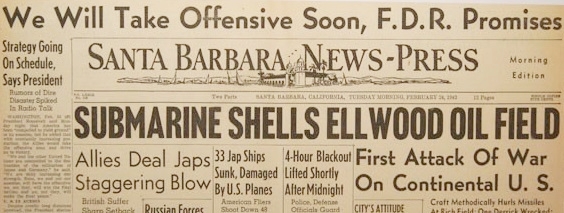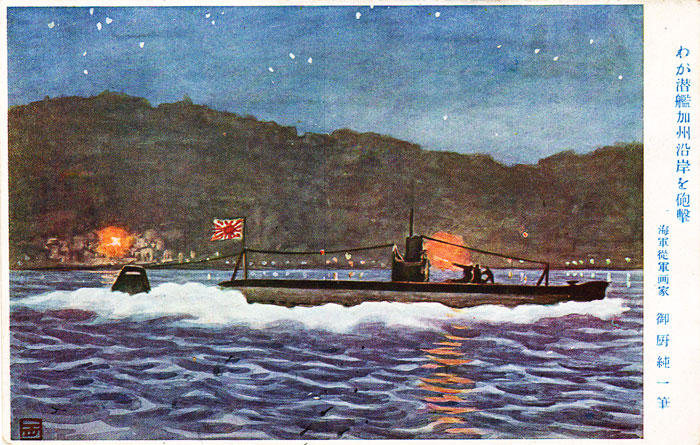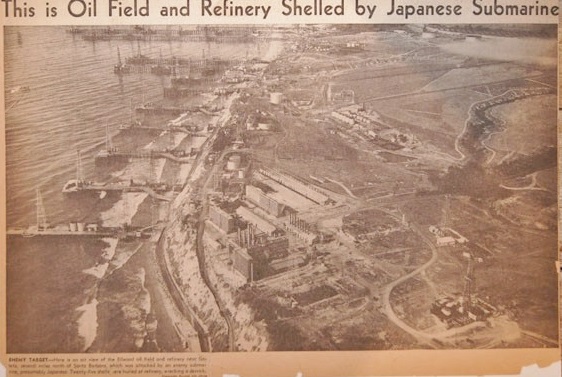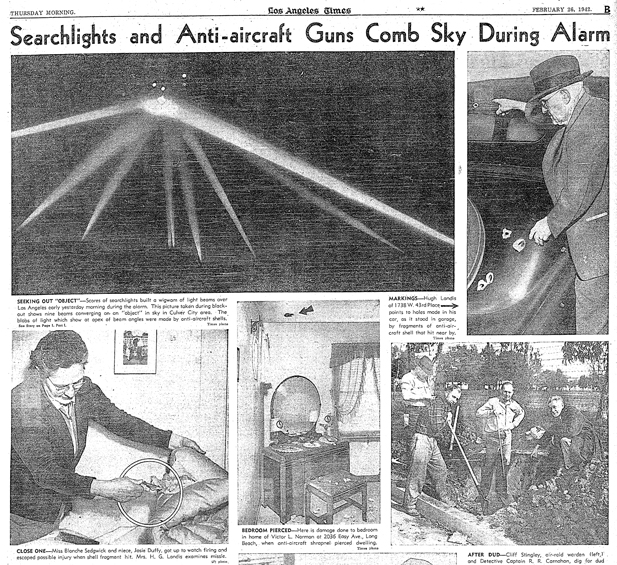Shelling of the Ellwood field at Santa Barbara created mass hysteria — and the “Battle of Los Angeles.”
Soon after America entered World War II, an Imperial Japanese Navy submarine attacked a refinery and oilfield near Los Angeles, the first attack of the war on the continental United States. The submarine’s deck gun fired about two dozen rounds, causing little damage — but it resulted in the largest mass sighting of UFOs in American history.

A February 1942 Imperial Japanese Navy submarine’s shelling of a California refinery caused little damage but created invasion (and UFO) hysteria in Los Angeles. Photo courtesy Goleta Valley Historical Society.
At sunset on February 23, 1942, Imperial Japanese Navy Commander Kozo Nishino and his I-17 submarine lurked 1,000 yards off the California coast. It was less than three months since the attack on Pearl Harbor, and Los Angeles residents were tense.

Japanese submarine I-17 bombarded the Ellwood, California, refinery and oilfield visited by its commander before the war.
Soon after dark, the I-17 surfaced and began firing armor-piercing shells at the Bankline Oil Company refinery in Ellwood, a small oilfield community 12 miles north of Santa Barbara.
The Ellwood oilfield, about five miles long and up to a mile wide, was discovered in 1928. Commander Nishino targeted oil storage tanks, piers and other facilities he had toured before the start of World War II.
Several of the shells struck while others passed over Wheeler’s Inn, whose owner reported the attack. “We heard a whistling noise and a thump as a projectile hit near the house,” recalled one witness. “I thought something was going wrong with the refiners.”

A Japanese postcard from World War II commemorates the I-17’s shelling the Ellwood refinery and storage facilities north of Santa Barbara. Image courtesy John Geoghegan.
The shelling continued for 20 minutes before I-17 escaped into the darkness. It was the first Axis attack on the continental United States of the war.
“Shell California! Enemy U-boat sends many shots into oilfields near Santa Barbara, entire area is blacked out,” declared the February 24 front page of the Chicago Tribune. Many newspapers began referring to the attack as the “Bombardment of Ellwood.”
Although there were no injuries and minimal damage (a wrecked derrick and pump house), the barrage led to a public panic that soon intensified. Witnesses claimed seeing offshore enemy “signal lights.”

Discovered in 1928 by Barnsdall-Rio Grande Company, Ellwood oilfield extended beyond the shore of Ellwood Beach. Photo courtesy Goleta Valley Historical Society.
Long after the war, Parade magazine in 1982 speculated that Commander Nishino targeted the Bankline Oil Company refinery because of a prewar affront. While serving on an oil tanker docked near the refinery and being given a courtesy tour of the facilities, the Japanese officer slipped and fell.
Commander Nishino apparently tumbled into a cactus — prompting laughter from his American hosts. The Parade magazine article speculated he would later seek his revenge by shelling the oil refinery.
After the attack, Nishino and his crew slipped away to new combat assignments in the Aleutians — unaware of the strange result of the attack on Ellwood’s refinery.
Despite missing their targets and dropping into the sea, on the beach, and into nearby cliffs, the Japanese artillery shells brought dramatic results. The evening attack not only fueled West Coast invasion fears, but quickly led to the largest mass UFO sighting in U.S. history.
UFOs and Mass Hysteria
Commander Nishino’s I-17 fired about two dozen rounds before making its way to Alaskan waters. As the “Bombardment of Ellwood” ended, the self-inflicted “Battle of Los Angeles” began.
At 3 a.m. on February 25, thousands of war-jittery California residents were awakened by sirens and anti-aircraft fire.

The Ellwood oilfield terminals and tanks along the coastline have long since disappeared — today occupied by the Sandpiper Golf Club, one of the top 25 courses in the country, according to Golf Digest.
“Scores of searchlights built a wigwam of light beaming over Los Angles,” noted the Los Angeles Times. The U.S. Army’s 37th Anti-Aircraft Brigade fired at elusive “unidentified airplanes.” The brigade fired 1,340 rounds.
Expecting the worst after the refinery attack, residents watched the illuminated nighttime sky. Soon there were sightings of “unidentified flying objects” in addition to enemy aircraft. “It was huge! It was just enormous! And it was practically right over my house,” reported one UFO observer about the attack.
“I had never seen anything like it in my life. It was just hovering there in the sky and hardly moving at all,” the witness added.

“Scores of searchlights built a wigwam of light beaming over Los Angles,” noted one reporter about the 1942 panic from a Japanese submarine shelling a refinery. U.S. Army anti-aircraft firing caused more damage than the enemy attack.
Anti-aircraft fire fell within the city, damaging homes and cars and fraying nerves. Many Los Angelenos imagined enemy aircraft. Others became fearful of extraterrestrial attackers.
Fast moving “red or silver objects” were seen high in the sky accompanied by “a large object that hung motionless” in midair. Anti-aircraft shells burst around it. Rumors of a government cover-up began.
Following the shelling of the Bankline Oil Company refinery and the Ellwood oilfield, an “Avenge Ellwood” fund-raising campaign was created in early 1943 for a war bond drive.
Historians have offered many explanations with detailed photo analysis of the “Battle of Los Angeles” and the panic that ensued. Several note the “Great Los Angeles Air Raid” resulted in the largest mass sighting of “UFO events” in American history.
In 2012, the Goleta Valley Historical Society hosted a special exhibition commemorating the 70th anniversary of the Ellwood shelling. The exhibit noted the widely publicized panic sadly increased support for Japanese-American internment camps.
_______________________
Recommended Reading: The Battle of Los Angeles, 1942: The Mystery Air Raid (2010); Pico Canyon Chronicles: The Story of California’s Pioneer Oil Field
(1985); Huntington Beach, California, Postcard History Series
(2009). Your Amazon purchase benefits the American Oil & Gas Historical Society. As an Amazon Associate, AOGHS earns a commission from qualifying purchases.
_______________________
The American Oil & Gas Historical Society (AOGHS) preserves U.S. petroleum history. Become an AOGHS annual supporting member and help maintain this energy education website and expand historical research. For more information, contact bawells@aoghs.org. © 2024 Bruce A. Wells. All rights reserved.
Citation Information – Article Title: “’Japanese Sub attacks Oilfield.” Authors: B.A. Wells and K.L. Wells. Website Name: American Oil & Gas Historical Society. URL: https://aoghs.org/petroleum-in-war/wwii-sub-attacks-oilfield. Last Updated: February 17, 2024. Original Published Date: February 24, 2015.


